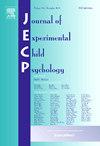Heroes, villains, and everything in between: Children’s assessment of morally ambiguous characters
IF 1.8
2区 心理学
Q3 PSYCHOLOGY, DEVELOPMENTAL
引用次数: 0
Abstract
Most research on the development of moral judgments has focused on children’s assessment of all-good or all-bad characters with little attention to the gray areas of morality. Yet real people’s behavior is often morally ambiguous, involving sometimes moral and sometimes immoral actions. In this study, we examined how 4-, 6-, and 8-year-old U.S. children (N = 72; 51% female) evaluate and respond to morally ambiguous characters. Children heard stories that each contained a purely moral character, a purely immoral character, and a morally ambiguous character. The 6- and 8-year-olds were more likely than the 4-year-olds to distinguish the ambiguous character from the moral and immoral characters. These age-related changes elucidate the development of children’s assessments of the “gray areas” of morality.
求助全文
约1分钟内获得全文
求助全文
来源期刊

Journal of Experimental Child Psychology
Multiple-
CiteScore
4.50
自引率
7.70%
发文量
190
期刊介绍:
The Journal of Experimental Child Psychology is an excellent source of information concerning all aspects of the development of children. It includes empirical psychological research on cognitive, social/emotional, and physical development. In addition, the journal periodically publishes Special Topic issues.
 求助内容:
求助内容: 应助结果提醒方式:
应助结果提醒方式:


